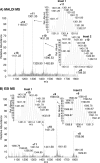Laserspray ionization, a new atmospheric pressure MALDI method for producing highly charged gas-phase ions of peptides and proteins directly from solid solutions
- PMID: 19955086
- PMCID: PMC2830846
- DOI: 10.1074/mcp.M900527-MCP200
Laserspray ionization, a new atmospheric pressure MALDI method for producing highly charged gas-phase ions of peptides and proteins directly from solid solutions
Abstract
The first example of a matrix-assisted laser desorption/ionization (MALDI) process producing multiply charged mass spectra nearly identical to those observed with electrospray ionization (ESI) is presented. MALDI is noted for its ability to produce singly charged ions, but in the experiments described here multiply charged ions are produced by laser ablation of analyte incorporated into a common MALDI matrix, 2,5-dihydroxybenzoic acid, using standard solvent-based sample preparation protocols. Laser ablation is known to produce matrix clusters in MALDI provided a threshold energy is achieved. We propose that these clusters (liquid droplets) are highly charged, and under conditions that produce sufficient matrix evaporation, ions are field-evaporated from the droplets similarly to ESI. Because of the multiple charging, advanced mass spectrometers with limited mass-to-charge range can be used for protein characterization. Thus, using an Orbitrap mass spectrometer, low femtomole quantities of proteins produce full-range mass spectra at 100,000 mass resolution with <5-ppm mass accuracy and with 1-s acquisition. Furthermore, the first example of protein fragmentation using electron transfer dissociation with MALDI is presented.
Figures





Similar articles
-
Commercial intermediate pressure MALDI ion mobility spectrometry mass spectrometer capable of producing highly charged laserspray ionization ions.Anal Chem. 2011 Feb 1;83(3):678-84. doi: 10.1021/ac102779e. Epub 2010 Dec 17. Anal Chem. 2011. PMID: 21166462
-
Matrix-assisted laser desorption/ionization mass spectrometry method for selectively producing either singly or multiply charged molecular ions.Anal Chem. 2010 Jan 1;82(1):11-5. doi: 10.1021/ac902066s. Anal Chem. 2010. PMID: 19904915
-
Producing highly charged ions without solvent using laserspray ionization: a total solvent-free analysis approach at atmospheric pressure.Anal Chem. 2011 Jun 1;83(11):4076-84. doi: 10.1021/ac2000576. Epub 2011 May 12. Anal Chem. 2011. PMID: 21520968
-
A perspective on MALDI alternatives-total solvent-free analysis and electron transfer dissociation of highly charged ions by laserspray ionization.J Mass Spectrom. 2010 May;45(5):471-85. doi: 10.1002/jms.1737. J Mass Spectrom. 2010. PMID: 20446310 Review.
-
A tutorial: Laserspray ionization and related laser-based ionization methods for use in mass spectrometry.Mass Spectrom Rev. 2023 Sep-Oct;42(5):2234-2267. doi: 10.1002/mas.21762. Epub 2023 Jul 18. Mass Spectrom Rev. 2023. PMID: 37462443 Review.
Cited by
-
Laserspray ionization (LSI) ion mobility spectrometry (IMS) mass spectrometry.J Am Soc Mass Spectrom. 2010 Jul;21(7):1260-4. doi: 10.1016/j.jasms.2010.03.039. Epub 2010 Apr 3. J Am Soc Mass Spectrom. 2010. PMID: 20435486
-
Laserspray ionization using an atmospheric solids analysis probe for sample introduction.J Am Soc Mass Spectrom. 2010 Nov;21(11):1889-92. doi: 10.1016/j.jasms.2010.07.005. Epub 2010 Jul 22. J Am Soc Mass Spectrom. 2010. PMID: 20732821
-
"Magic" Ionization Mass Spectrometry.J Am Soc Mass Spectrom. 2016 Jan;27(1):4-21. doi: 10.1007/s13361-015-1253-4. J Am Soc Mass Spectrom. 2016. PMID: 26486514 Free PMC article.
-
Carbonation and other super saturated gases as solution modifiers for improved sensitivity in solvent assisted ionization inlet (SAII) and ESI.J Am Soc Mass Spectrom. 2013 Feb;24(2):186-92. doi: 10.1007/s13361-012-0535-3. Epub 2013 Jan 8. J Am Soc Mass Spectrom. 2013. PMID: 23296909
-
Advances in Mass Spectrometric Tools for Probing Neuropeptides.Annu Rev Anal Chem (Palo Alto Calif). 2015;8:485-509. doi: 10.1146/annurev-anchem-071114-040210. Epub 2015 Jun 11. Annu Rev Anal Chem (Palo Alto Calif). 2015. PMID: 26070718 Free PMC article. Review.
References
-
- Karas M., Glückmann M., Schäfer J. ( 2000) Ionization in matrix-assisted laser desorption/ionization: singly charged molecular ions are the lucky survivors. J. Mass Spectrom 35, 1– 12 - PubMed
-
- Glückmann M., Pfenninger A., Krüger R., Thierolf M., Karas M., Horneffer V., Hillenkamp F., Strupat K. ( 2001) Mechanisms in MALDI analysis: surface interaction or incorporation of analytes? Int. J. Mass Spectrom 210/211, 121– 132
-
- Fournier I., Brunot A., Tabet J. C., Bolbach G. ( 2002) Delayed extraction experiments using a repulsive potential before ion extraction: evidence of clusters as ion precursors in UV-MALDI. Part I: dynamical effects with the matrix 2,5-dihydroxybenzoic acid. Int. J. Mass Spectrom 213, 203– 215 - PubMed
-
- Knochenmuss R. ( 2003) A quantitative model of ultraviolet matrix-assisted laser desorption/ionization including analyte ion generation. Anal. Chem 75, 2199– 2207 - PubMed
-
- Knochenmuss R. ( 2006) Ion formation mechanisms in UV-MALDI. Analyst 131, 966– 986 - PubMed
Publication types
MeSH terms
Substances
LinkOut - more resources
Full Text Sources
Other Literature Sources

